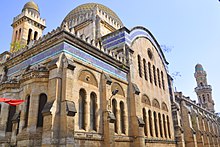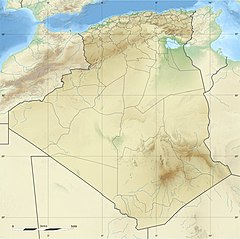Ketchaoua Mosque
This article needs to be updated. (April 2024) |
| Ketchaoua Mosque – جامع كتشاوة | |
|---|---|
 | |
| Religion | |
| Affiliation | Islam |
| Location | |
| Location | Algiers, Algeria |
| Geographic coordinates | 36°47′6″N 3°3′38″E / 36.78500°N 3.06056°E |
| Architecture | |
| Type | Mosque |
| Style | Moorish, Byzantine |
| Completed | 1612 |
| Minaret(s) | 2 |
The Ketchaoua Mosque (Arabic: جامع كتشاوة), also known as Djamaa Ketchaoua, is a mosque in the city of Algiers, the capital of Algeria. It was built during Ottoman period in the 17th century and is located at the foot of the Casbah of Algiers, a UNESCO World Heritage Site. The mosque stands on the first of the Casbah's many steep stairways and was logistically and symbolically a cynosure of pre-colonial Algiers.[1][2][3] The mosque is noted for its unique fusion of Moorish and Byzantine architecture.[4]
The mosque was originally built in 1612. In 1845 it was converted under French rule, to the Cathedral of St Philippe which it remained until 1962. The old mosque was demolished between 1845 and 1860 and a new church was built and converted into a mosque in 1962. In spite of these transitions, the mosque has retained its original grandeur and is one of the major attractions of Algiers.[4][5]
Geography[edit]
Ketchaoua Mosque is located in the historic Casbah of Algiers in the southern part of the city, approximately 250 metres east of the Djamaa el Kebir mosque, near the Archbishop's Palace of Algiers and National Library of Algeria. The mosque, built during the city's Ottoman period, was once at the centre of the city. Its strategic location on the first of the Casbah's stairways leading to the five gates of the city, lies in the aristocratic district where lived the rich and the famous royal family members of the Ottoman Regency, the politically prominent, and business magnates. It was built on the site of an icosium, a Phoenician settlement at the site of the mosque.[1][2][3][6]
History[edit]
Origins[edit]
The Casbah (fortress), next to the Mediterranean Sea shore, is a unique kind of medina, or Islamic city, which predates construction of the Ketchaoua Mosque at its centre. It overlooks the islands where a Carthaginian trading-post was established in the 6th century BC, but the city of Algiers was founded in the 10th century by the Zirids. Over the next several centuries the Berbers, Romans, Byzantines, Arabs and Spaniards all made an impact.

The history of the Ketchaoua Mosque is integral to the ancient history of the Casbah, recognized on the UNESCO World Heritage List. Its exact location was at the centre of the city at the intersection of the roads from the lower Casbah leading to the five gates of the Algiers city. An unconfirmed mention is made of the mosque in the 14th century, but the confirmed "notarial document" dates it to 1612. However, it was rebuilt by Hasan Pasha according to a commemorative inscription in the later part of the 18th century, when it was glorified as a structure of "unparalleled beauty.”
Modern period[edit]
In 1832, the mosque was converted into a cathedral named "St. Philippe Cathedral" by the French. In 1838, following the conquest of the Algerian city of Constantine by the France, Marshal Sylvain Charles Valée had a cross mounted on top of the cathedral. Between 1845 and 1860 the old mosque was demolished and a new church was built. After the liberation of Algeria from French rule, the cathedral's restoration as the Ketchaoua Mosque in 1962 is considered as "having significant religious and cultural importance," and it richly testifies to the history of "this mosque-turned-cathedral-turned-mosque".[6] The rededication of the cathedral into a mosque was performed in the first year of Algerian independence, in a formal ceremony presided over by Tawfiq al Madani, the Minister of Harbours, held at the Ben Badis Square (earlier known as Lavigere). This event has also been described as "correlatively for the reconquest of Algeria’s authenticity as a supreme symbol of the nation’s recovery of its integrity."[3][6] The bells of the cathedral were given in 1965 to the church of Le Vieux-Marché where Louis Massignon had established a Christian-Muslim pilgrimage during the independence war.[7]
Apart from the Ketchaoua Mosque, there are remains of the citadel, other old mosques and Ottoman-style palaces, as well as the remains of a traditional urban structure.[1][2]
Architecture[edit]
The principal entrance to the mosque is through a flight of 23 steps. At the entrance is an ornamented portico supported by four black-veined marble columns. Inside the mosque are arcades of white marble columns. The beauty of the mosque's chambers, minarets and ceilings is accentuated by the distinctly Moorish plaster work. The mosque overlooks the public square in the Casbah, with the sea in front; it has two octagonal minarets flanking the entrance, with Byzantine and Moorish design and decorations. Many of the white marble columns belong to the original mosque. There is a tomb with the remains of San Geronimo enshrined in one of the chambers in the mosque.[4][6]
Restoration[edit]

In 2009, the Heritage Department of Algeria began improvements to the octagonal minarets, the central vault of the main fascia and the abutting staircase inside the mosque. These were to be completed over a 12 months schedule.[8] With the minaret of Ketchaoua Mosque, which was on the brink of partial collapse, under restoration, plans were developed for implementation in three stages, including the restoration of the Casbah itself, in more general terms. This plan, launched in September 2008, covers the renovation of several mosques in old Algiers and the conversion of a number of houses into libraries at an initial cost of 300 million Algerian dinars.[9]
Images[edit]
See also[edit]
- Algerian Islamic reference
- Hizb Rateb (Hezzab, Bash Hezzab, Salka)
- Lists of mosques
- List of mosques in Africa
- List of mosques in Algeria
- Islam in Algeria
- Dar Hassan Pacha
References[edit]
- ^ a b c "Kasbah of Algiers". Unesco. Retrieved 2010-11-12.
- ^ a b c "Algiers Kasbah: 1992Evaluation" (PDF). Unesco. Retrieved 2010-11-14.
- ^ a b c McDougall, James (2006). History and the culture of nationalism in Algeria. Cambridge University Press. pp. 217–220. ISBN 0-521-84373-1. Retrieved 2010-11-14.
- ^ a b c "Visit the Historic Ketchaoua Mosque in Algiers". Algeria.com. Retrieved 2010-11-12.
- ^ "Mosques converted from churches / cathedrals / synagogues". World Heritage Site. Archived from the original on 2011-08-04. Retrieved 2010-11-12.
- ^ a b c d "The Magnificent Ketchaoua Mosque in Algiers" (PDF). Travel North Africa Times. 2008-04-12. Archived from the original (PDF) on 2011-07-22. Retrieved 2010-11-12.
- ^ O'Mahony, Anthony (18 November 2021). "Louis Massignon, the Seven Sleepers of Ephesus and the Christian-Muslim pilgrimage at Vieux-Marché, Brittany". In Bartholomew, Craig; Hughes, Fred (eds.). Explorations in a Christian Theology of Pilgrimage. Routledge. pp. 126–149. ISBN 978-1-351-93766-5. Retrieved 31 January 2024.
- ^ "Ketchaoua Mosque under urgent works in coming days". Algeria News and Press Reviews. 2009-12-13. Archived from the original on 2011-05-17. Retrieved 2010-11-14.
{{cite web}}: CS1 maint: bot: original URL status unknown (link) - ^ "The Casbah of Algiers heaves a cry of despair". Magharebia. 2008-10-03. Retrieved 2010-11-14.
Further reading[edit]
- Ghoche, Ralph (2020). "Erasing the Ketchaoua Mosque: Catholicism, assimilation, and civic identity in France and Algeria". In Coslett, Daniel E. (ed.). Neocolonialism and Built Heritage: Echoes of Empire in Africa, Asia, and Europe. Routledge. pp. 87–105. ISBN 978-0-429-76951-1.







